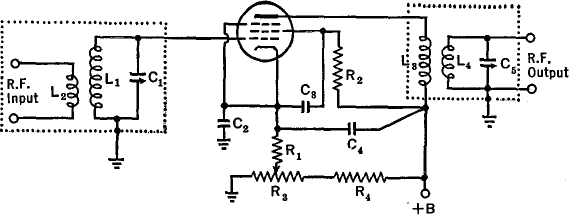| Basic Radio is a free introductory textbook on electronics based on tubes. See the editorial for more information.... |

|

Home  Amplifiers Amplifiers  R.F. and I.F. Amplifiers R.F. and I.F. Amplifiers  Typical R.F. Class A Amplifier Typical R.F. Class A Amplifier |
||||||||||||||||||||






|
||||||||||||||||||||
|
Typical R.F. Class A AmplifierAuthor: J.B. Hoag
Figure 27 A shows the type of r.f. amplifier commonly used in receiver circuits. The input and output circuits L1C1 and L4C5 are tuned to the same frequency.
Bypass condensers C2, C3, and C4 should have low reactance at the frequencies to be amplified; 0.01 μfd. for ordinary communication purposes. The cathode resistor R1 should establish the minimum bias voltage recommended for the particular tube used. In applying Ohm's law to calculate R1 do not forget that both the screen and plate currents flow through R1. Ohm's law is also used to calculate R2, such that the voltage drop in it due to the screen current, subtracted from the B voltage, leaves the correct screen voltage. The tuned circuits should have a fairly high L/C ratio. L3 is usually coupled as closely to L4 as possible and contains 70 to 80 per cent of the number of turns on L4. With variable-μ tubes, the gain control is accomplished by changing the C-bias voltage. There are three currents passing through the control resistor R3, i.e., the bleeder current through R4, the screen, and the plate current. The total drop across R3 should be about 50 volts. Maximum gain occurs when the sliding contact on R3 is at the grounded end. In multistage amplifiers, the lower ends of the various cathode resistors are sometimes connected together and then to the sliding contact on R3. The left end of R3 must then have a current-carrying capacity sufficient for all the tube currents plus that of the bleeder R4.
|
||||||||||||||||||||
Home  Amplifiers Amplifiers  R.F. and I.F. Amplifiers R.F. and I.F. Amplifiers  Typical R.F. Class A Amplifier Typical R.F. Class A Amplifier |
||||||||||||||||||||
Last Update: 2010-11-27


